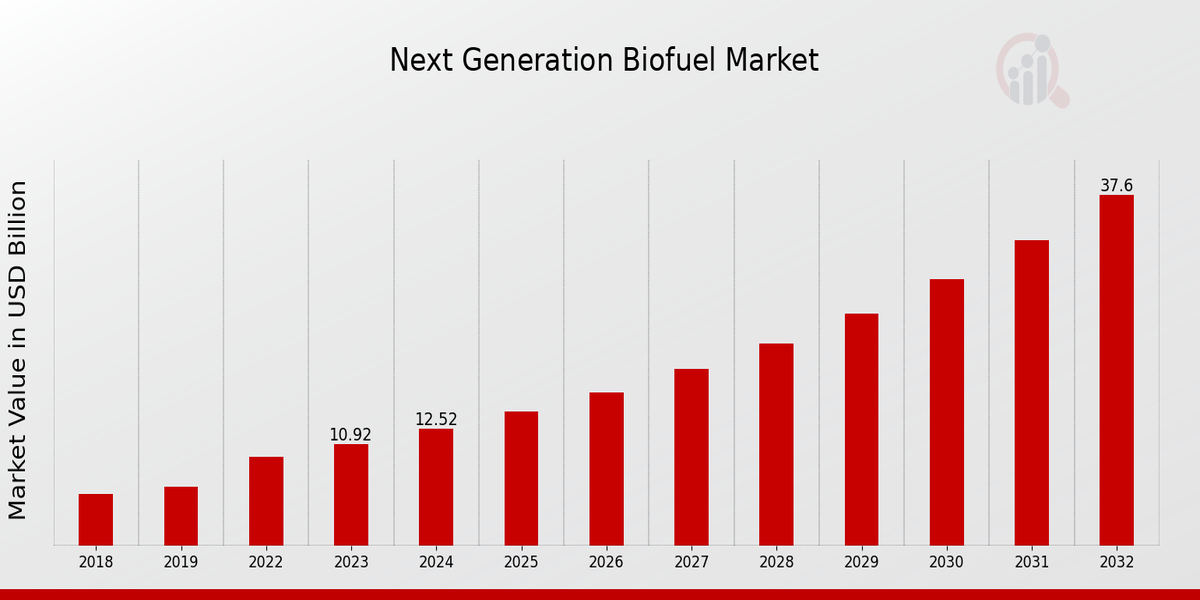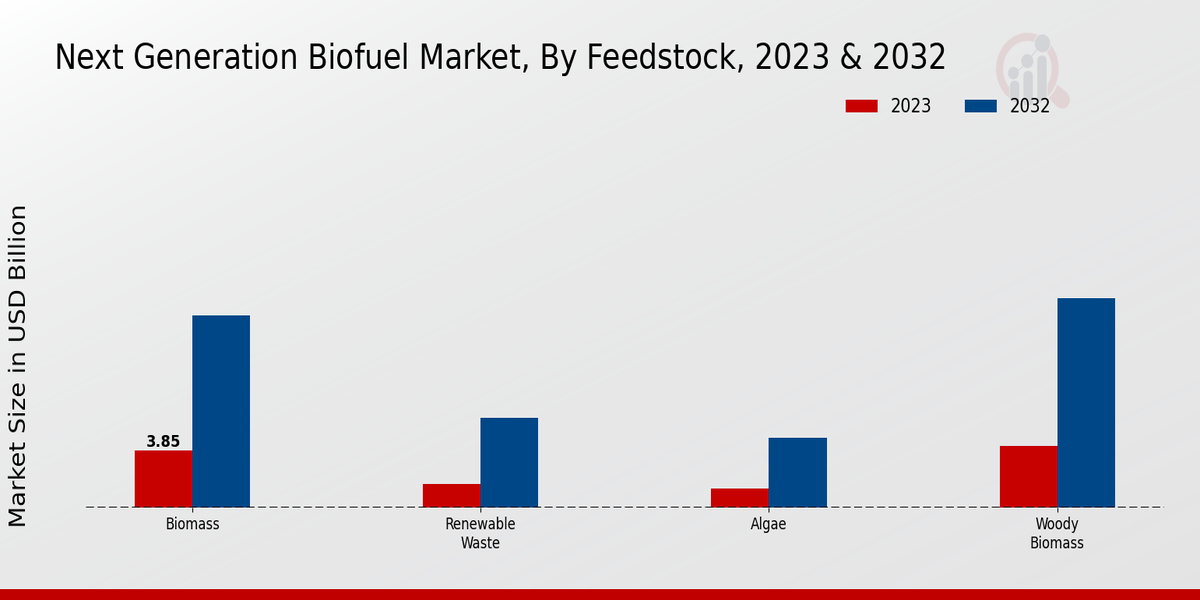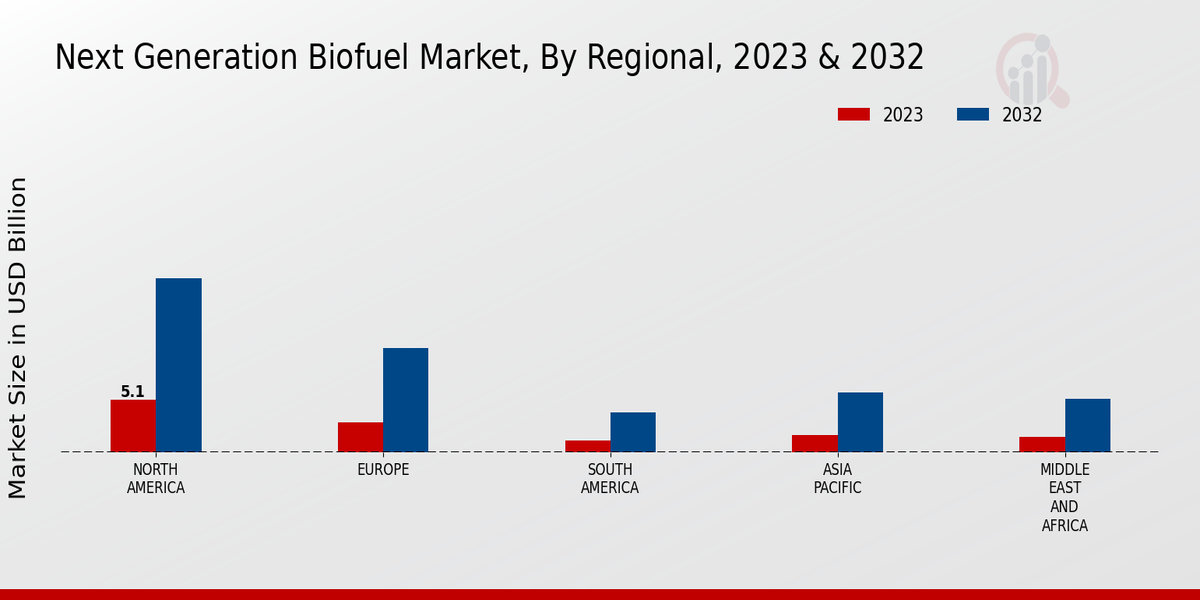Global Next-Generation Biofuel Market Overview
As per MRFR analysis, the Next-Generation Biofuel Market Size was estimated at 9.51 (USD Billion) in 2022. The Next-Generation Biofuel Market Industry is expected to grow from 10.92(USD Billion) in 2023 to 37.6 (USD Billion) by 2032. The Next-Generation Biofuel Market CAGR (growth rate) is expected to be around 14.73% during the forecast period (2024 - 2032).
Key Next-Generation Biofuel Market Trends Highlighted
The Next-Generation Biofuel Market is experiencing significant growth, driven by advancements in technology and increasing demand for sustainable energy sources. Key market drivers include government incentives and regulations promoting the adoption of renewable fuels, rising environmental concerns, and the need to reduce greenhouse gas emissions. The market is also witnessing a trend towards the production of biofuels from non-food crops, such as algae and waste biomass, to avoid competition with food production. Additionally, advancements in catalytic processes and enzyme technology are enabling the efficient conversion of biomass into biofuels.

Source: Primary Research, Secondary Research, MRFR Database and Analyst Review
Next-Generation Biofuel Market Drivers
Rising Environmental Concerns and Stringent Regulations
One-dimensional growth of fossil fuels leads the environmental damage, thus making it imperative to steer further away from greenhouse gases as depicted by regulations in place. Hence, the demand for alternative resources steers forward. In this regard, Next-Generation Biofuels can be said to have characteristic properties addressing the issue as they produce lower emissions than burning fossil fuels. The same concern is driving the governments in the world to introduce strategies and policies encouraging the use of biofuels.
In addition, policies making it compulsory to incorporate biofuels with ordinary fuels act as a positive added incentive to the Global Next-Generation Biofuels Market Industry.
Next-GenerationAdvancements in Feedstock Utilization and Production Technologies
Technological advancements in feedstock utilization and production processes are significantly contributing to the growth of the Next-Generation Biofuel Market Industry. Researchers and industry players are exploring diverse feedstocks, such as algae, lignocellulosic biomass, and waste materials, to produce biofuels. These feedstocks offer cost-effective and sustainable alternatives to traditional feedstocks like corn and sugarcane. Additionally, innovations in production technologies, such as enzyme-based processes and hydrothermal liquefaction, are improving the efficiency and reducing the costs of biofuel production.
Growing Demand for Renewable Energy Sources
The increasing global demand for renewable energy sources is another key driver for the Next-Generation Biofuel Market Industry. As countries strive to transition to cleaner energy systems, biofuels are emerging as a promising option. Biofuels can be utilized in various sectors, including transportation, power generation, and industrial applications. Their versatility and ability to reduce dependence on fossil fuels make them an attractive solution for meeting renewable energy targets.
Next-Generation Biofuel Market Segment Insights
Next-Generation Biofuel Market Feedstock Insights
The feedstock segment plays a crucial role in the Next-Generation Biofuel Market, directly impacting the industry's growth. Biomass, a prominent feedstock, is derived from plant matter and accounts for a significant share of the market. Renewable waste, including agricultural and municipal waste, offers cost-effective and sustainable feedstock options. Algae, with its high lipid content, has gained attention as a promising feedstock for biodiesel production. Woody biomass, a type of lignocellulosic feedstock, is also gaining traction due to its abundance and potential for biofuel production.The Next-Generation Biofuel Market revenue for the feedstock segment is projected to reach USD 25.48 billion by 2024, showcasing consistent market growth. The segmentation of the feedstock market provides valuable insights into the dynamics and trends shaping the industry. Next-Generation Biofuel Market data indicates that biomass is the dominant feedstock, accounting for over USD 3.854 billion of the market share in 2023. Renewable waste is expected to experience significant growth, with a projected CAGR of 16.5% during the forecast period from 2023 to 2032.Algae and woody biomass are emerging feedstocks with immense potential, offering sustainable and cost-effective alternatives for biofuel production. The Next-Generation Biofuel Market statistics reflect the increasing demand for renewable and sustainable energy sources. The industry is witnessing a shift towards advanced feedstocks that offer higher yields, reduce environmental impact, and enhance overall biofuel production efficiency. The availability and accessibility of feedstocks are crucial factors influencing regional market dynamics.Government policies and regulations play a significant role in promoting the use of sustainable feedstocks, shaping the Next-Generation Biofuel Market landscape. Overall, the feedstock segment presents a diverse and evolving landscape, with ongoing research and development efforts focused on optimizing feedstock utilization and enhancing biofuel production processes. The industry's growth prospects are tied to the development of sustainable and efficient feedstock supply chains, ensuring the long-term viability and competitiveness of the Next-Generation Biofuel Market.

Source: Primary Research, Secondary Research, MRFR Database and Analyst Review
Next-Generation Biofuel Market Technology Insights
Technology Segment Insights and Overview The Next-Generation Biofuel Market is segmented based on technology into gasification, pyrolysis, hydrothermal liquefaction, and anaerobic digestion. Among these, the gasification segment held the largest market share in 2023 and is projected to continue its dominance throughout the forecast period. This can be attributed to the high efficiency and versatility of gasification technology, which allows for the conversion of a wide range of feedstocks into biofuels. Pyrolysis is another promising technology that is gaining traction in the next-generation biofuel market.Pyrolysis involves the thermal decomposition of biomass in the absence of oxygen, resulting in the production of bio-oil, char, and gases. The bio-oil can be further refined into transportation fuels, while the char can be used for energy generation or soil amendment. Hydrothermal liquefaction is a relatively new technology that has shown potential for the conversion of wet biomass into biocrude. This process involves heating biomass in water under high pressure, resulting in the breakdown of complex organic compounds into simpler molecules. The biocrude can then be upgraded into transportation fuels or other valuable products.Anaerobic digestion is a well-established technology that has been used for the production of biogas from organic waste for many years. In the context of next-generation biofuels, anaerobic digestion can be used to convert a variety of feedstocks, including agricultural residues, into biogas, which can be further upgraded into biomethane for use as a transportation fuel.
Next-Generation Biofuel Market Product Type Insights
The Next-Generation Biofuel Market segmentation by product type includes biodiesel, renewable diesel, bioethanol, and biogas. Biodiesel is expected to hold the largest market share in 2023, accounting for over 40% of the global market revenue. The increasing demand for biodiesel from the transportation sector, particularly in the aviation industry, is driving the growth of this segment. Renewable diesel, which is a cleaner and more sustainable alternative to traditional diesel, is also gaining popularity and is expected to witness significant growth in the coming years.Bioethanol, primarily used in the production of alcoholic beverages and as a biofuel, is expected to have a stable market share, while biogas, which is produced from organic matter, is expected to witness moderate growth due to its increasing use in power generation and transportation.
Next-Generation Biofuel Market End-Use Application Insights
The end-use application segment of the Next-Generation Biofuel Market is categorized into transportation, power generation, and heating and cooling. Among these, the transportation sector dominates the market, accounting for over 60% of the Next-Generation Biofuel Market revenue in 2023. The increasing demand for sustainable transportation fuels, coupled with government regulations promoting the use of biofuels, drives growth in this segment. The power generation segment is expected to grow significantly in the coming years due to rising concerns over climate change and the need for renewable energy sources.The heating and cooling segment is also expected to witness steady growth, attributed to the growing demand for sustainable heating and cooling solutions in residential, commercial, and industrial sectors.
Next-Generation Biofuel Market Regional Insights
The Next-Generation Biofuel Market is segmented into North America, Europe, APAC, South America, and MEA. North America is expected to hold the largest market share in 2023, owing to the presence of well-established biofuel industries in the United States and Canada. Europe is expected to be the second-largest market, driven by the increasing adoption of renewable energy sources and stringent environmental regulations. APAC is expected to witness significant growth in the coming years due to the rising demand for biofuels in countries such as China and India.South America and MEA are expected to have a relatively smaller market share but are expected to grow at a steady pace.

Source: Primary Research, Secondary Research, MRFR Database and Analyst Review
Next-Generation Biofuel Market Key Players And Competitive Insights
Major players in the Next-Generation Biofuel Market are continuously innovating and investing in research and development to gain a competitive edge. The Next-Generation Biofuel Market industry is characterized by a high degree of competition, with Leading Next-Generation Biofuel Market players vying for market share. The Next-Generation Biofuel Market development includes strategic partnerships, acquisitions, and collaborations to expand its product portfolio and geographical reach. The competitive landscape is likely to remain dynamic due to technological advancements and increasing demand for sustainable energy sources.One of the leading players in the Next-Generation Biofuel Market is Neste. The company is headquartered in Finland and is engaged in the production and sale of renewable fuels, renewable feedstocks, and chemicals. Neste has a strong focus on sustainability and is committed to reducing its carbon footprint. The company's Next-Generation Biofuel Market offerings include renewable diesel, sustainable aviation fuel, and renewable feedstocks for the production of bioplastics.A major competitor in the Next-Generation Biofuel Market is Renewable Energy Group. The company is headquartered in the United States and is engaged in the production and sale of renewable fuels, including biodiesel and renewable diesel. Renewable Energy Group has a strong presence in the North American market and is expanding its operations globally. The company's Next-Generation Biofuel Market offerings include biodiesel, renewable diesel, and renewable jet fuel.
Key Companies in the Next-Generation Biofuel Market Include
- AltEnergy
- Renewable Energy Group
- Bunge
- Solidia Technologies
- LanzaTech
- Green Plains
- Neste
- Amyris
- POETDSM
- bioprocess algae
- Phillips 66
- Aemetis
- Valero Energy
- Gevo
- Zymergen
- Syntroleum
Next-Generation Biofuel Market Industry Developments
The Next-Generation Biofuel Market is poised to witness significant growth over the coming years, driven by concerns over climate change and the need for sustainable energy sources. In 2023, the market is valued at USD 10.92 billion and is projected to reach USD 37.6 billion by 2032, exhibiting a CAGR of 14.73%.Recent developments include the announcement by the US Department of Energy of a USD 5.6 million grant to Lanzatech for the development of a sustainable aviation fuel production facility in Georgia, USA. Additionally, the European Union has set a target of 14% renewable energy consumption in transport by 2030, which is expected to boost the demand for next-generation biofuels.
-
Next-Generation Biofuel Market Segmentation Insights
-
Next-Generation Biofuel Market Feedstock Outlook
- Biomass
- Renewable Waste
- Algae
- Woody Biomass
-
Next-Generation Biofuel Market Technology Outlook
- Gasification
- Pyrolysis
- Hydrothermal Liquefaction
- Anaerobic Digestion
-
Next-Generation Biofuel Market Product Type Outlook
- Biodiesel
- Renewable Diesel
- Bioethanol
- Biogas
-
Next-Generation Biofuel Market End-Use Application Outlook
- Transportation
- Power Generation
- Heating and Cooling
-
Next-Generation Biofuel Market Regional Outlook
-
North America
-
Europe
-
South America
-
Asia Pacific
-
Middle East and Africa
| Report Attribute/Metric |
Details |
| Market Size 2022 |
9.51(USD Billion) |
| Market Size 2023 |
10.92(USD Billion) |
| Market Size 2032 |
37.6(USD Billion) |
| Compound Annual Growth Rate (CAGR) |
14.73% (2024 - 2032) |
| Report Coverage |
Revenue Forecast, Competitive Landscape, Growth Factors, and Trends |
| Base Year |
2023 |
| Market Forecast Period |
2024 - 2032 |
| Historical Data |
2019 - 2023 |
| Market Forecast Units |
USD Billion |
| Key Companies Profiled |
AltEnergy, Renewable Energy Group, Bunge, Solidia Technologies, LanzaTech, Green Plains, Neste, Amyris, POETDSM, bioprocess algae, Phillips 66, Aemetis, Valero Energy, Gevo, Zymergen, Syntroleum |
| Segments Covered |
Feedstock, Technology, Product Type, End-Use Application, Regional |
| Key Market Opportunities |
Growing aviation sector Rising demand for sustainable fuels Favorable government policies Technological advancements Expansion into new geographical markets |
| Key Market Dynamics |
Rapid technological advancements Growing environmental concerns Government incentives and regulations Increasing demand for sustainable energy sources Rising awareness of biofuels benefits |
| Countries Covered |
North America, Europe, APAC, South America, MEA |
Frequently Asked Questions (FAQ) :
The Next-Generation Biofuel Market is expected to be valued at 10.92 billion USD in 2023.
The Next-Generation Biofuel Market is expected to grow at a CAGR of 14.73% from 2024 to 2032.
North America is expected to hold the largest market share in the Next-Generation Biofuel Market in 2023.
The transportation segment is expected to hold the largest market share in the Next-Generation Biofuel Market in 2023.
Some of the key competitors in the Next-Generation Biofuel Market include Neste, Gevo, and AltEnergy.
The key factors driving the growth of the Next-Generation Biofuel Market include the increasing demand for sustainable fuels, the rising cost of fossil fuels, and the government regulations supporting the use of biofuels.
The challenges facing the Next-Generation Biofuel Market include the high cost of production, the lack of infrastructure, and the competition from fossil fuels.
The opportunities for growth in the Next-Generation Biofuel Market include the increasing demand for sustainable fuels, the rising cost of fossil fuels, and the government regulations supporting the use of biofuels.
The key trends in the Next-Generation Biofuel Market include the development of new technologies, the increasing use of biofuels in transportation, and the growing demand for sustainable fuels.
The Next-Generation Biofuel Market is expected to be valued at 37.6 billion USD in 2032.

















